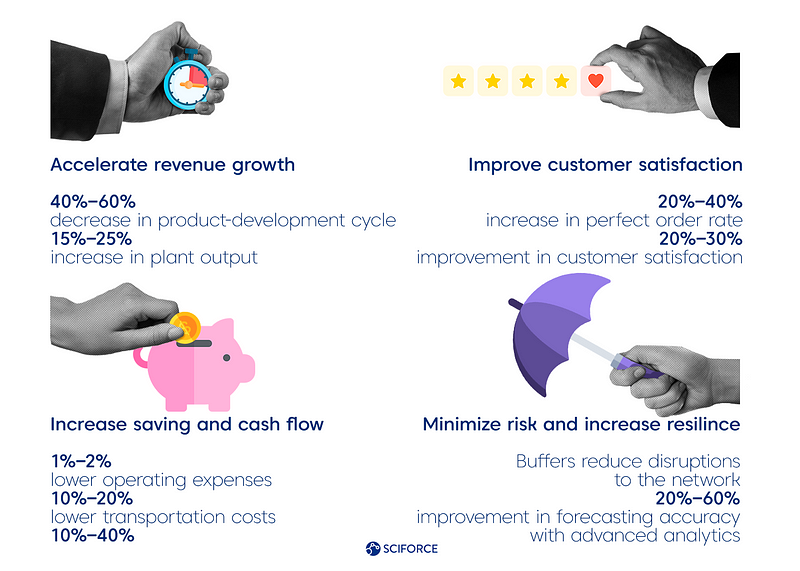Why use AI in Retail? (Plus Best Practices)

Artificial Intelligence (AI) and retail are a good fit. The COVID-19 pandemic has accelerated digital transformation worldwide and is whipping up different business verticals to adopt various AI technologies. As per the UNCTAD survey, more than half of consumers of the emerging and developed economies are shopping online. The part of AI in the retail market in 2020 was valued at USD 1,80 billion and is expected to reach USD 10,90 billion at a CAGR of 35% by 2026.
It seems like it is high time for going big or going home for retailers. The latest AI technologies are already helping early adopters with managing products and supply chains, improving operational efficiency, and meeting the expectations of the more demanding consumers.
We are presenting a close-up on how to benefit from these changes. Read on to find out the best practices of using AI in retail and e-commerce in 2021.
Consumers are going deeper in digital than ever before. The brightest example is Amazon, which has increased its profit by 200% since the beginning of the COVID-19 pandemic. It made Jeff Bezos 80% richer at the beginning of 2021 than before the pandemic.
Apart from e-commerce, consumers tend to choose the internet for news, information related to health issues, and entertainment, leaving more data online. This fact implies two principal tasks: meeting the growing and ever-changing demand of consumers online and discovering valuable data-driven insights.
Simultaneously, different generations of customers expect a personal touch from the markets in the time of uncertainty. For example, the younger generation recognizes the need to save more money than 55+ years old customers (43% vs. 20% correspondingly according to the Kantar research). It means that retailers should listen to their consumers and choose the appropriate pricing strategy.
At the same time, the younger generation is far more open to reward brands providing excellent customer experience more than Boomers (44% vs. 31%, correspondingly). Thus, chatbots, recommender systems, and data-driven business intelligence enter the picture. When customers are spending more of their time online and are interacting with various brands each day, investing in qualitative customer experience is crucial.
Far-flung supply chains are vulnerable, and it is a fact. While some groups of society are undergoing vaccination against coronavirus and the global economy starts recovering, retailers are still adapting their supply chains to the new normal. And this new normal implies mobility restrictions, closing the factories for quarantines, and slowing down the logistics flows.
Though it is still hard to assess the impact of the corona crisis on the global economy, the one is clear — the recovery lasts long. For example, one of the global electronics manufacturers’ revenue decreased to 66% after the series of earthquakes in Japan in 2016. Recovery time for this case reached one year. Hence, reducing the level of dependency on far-flung supply chains and developing resilience with the help of AI comes in handy as never before.
Per Bain & Company research, flexible and resilient supply chains are accelerating revenue growth, improving customer satisfaction, increasing savings and cash flow, and minimizing risks. See the infographics below for more details.

Resilient supply chains competitive advantage
So, how exactly the supply chain can develop resilience with AI under uncertainty? As per research, you should invest in these five capabilities to build a resilient supply chain, counting on the latest technologies:
Counting on the AI-powered tools, empowered teams can develop the rapid-recovery plan to help companies navigate smoothly under uncertainty.
Retailers can precisely focus on customers, delegating day-to-day operations to AI-powered solutions. Improving operational efficiency implies a wide range of advanced practices, from automated monitoring inventories to using computer vision for notifying when to restock the market’s shelves. Such applications can speed up your decision-making, extend capabilities, and increase competitive advantage.

Retailers can precisely focus on customers, delegating day-to-day operations to AI-powered solutions.
Per MarTech Series, about 83% of marketers could run their campaigns more successfully using location data. Thus, using geotargeting, you can ensure that more relevant content will appear on consumer’s screens. By implementing a location marketing strategy, you can get a higher consumer engagement rate and more response.
AI virtual sales assistance or AI sales assistants are the tools that are mainly used by sales and marketing specialists to automate routine tasks. Instead of manually managing the pipeline, qualifying leads, or generating forecasts, retailers can focus on strategic tasks. Leave all the minor but still important tasks to AI-powered tools.
Indoor analytics can bring you the answers on how many customers visit the premises, the exact areas they see, and the time spent per location. Simultaneously, you can also define which sites are not receiving enough of the customer’s attention and what is the customer’s flow in your store.
However, one of the challenges of indoor analytics is the collecting of data 24/7. Not every system of the commercial facilities can resist such load, and it requires the help of the latest technologies like computer vision.
We have developed a solution for checkout area queue detecting and occupied premise’s area detecting for one of the European grocery chains, VARUS, and Ukraine’s top personal care retailer, EVA. It helped a retailer boost its effectiveness and optimize customer service using a queue detection model for more than 400 cameras.
AI technologies also are the basis of modern predictive and prescriptive analytics. It is the way to get the answers to the questions “What is going to happen next?” and “How can I benefit from the current situation?”. Having a unique solution empowered by machine learning, you can clearly define the future market trends, predict your following scenarios, and have a competitive advantage.
Pricing optimization means finding the most effective price point that maximizes sales. It is built on data like customer survey data, demographics, inventories, historical sales data, operating costs, etc. Let AI technologies deal with all of these to stay tuned-up in the dynamic changing environment.
Voice-assisted commerce is the way of customer and brand interaction via voice recognition technology. Meanwhile, voice commerce does not imply online shopping only. According to Adobe Digital Insights, customers use speakers to create shopping lists, conduct product research, and compare prices. Per Zion Market research, the voice commerce speaker market will reach $30 billion by 2024. Check our SEO in Times of Voice-Activated Apps: How to Make Voice Search Work for You post for more details.
Customers are looking for a product online with their photos or pictures instead of googling keywords, making visual search a growing trend in online shopping. As per ViSenze research, 62% of Millennials and Gen Z customers want visual search capabilities while shopping to identify the needed products quickly.
Apparel brands like Tommy Hilfiger and ASOS have already implemented these technologies for a smooth customer experience. This solution helps to make the path from search to conversion shorter, integrate online and offline shopping experience, track and measure results efficiently.
Why should retail use AI? It is a robust set of tools that can help retailers to build resilience under uncertainty. AI is intertwined with almost every retail industry, starting from chatbots that improve and scale customer experience to indoor analytics that help to plan the next strategic steps. Since more consumers rely on the online shopping experience, retailers should rely on the latest advancements to gain a competitive advantage.